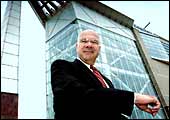 |
| FM Chidambaram: Can't wait to fix the
pension problem |
It is easy to
understand finance minister P. Chidambaram's desperation to set
up the proposed Pension Fund Regulatory and Development Authority
(PFRDA). Despite moving away from the "defined benefit plan"
(contribution coming only from the government) on January 1, 2004,
to a more realistic "defined contribution plan" (matching
contribution by government and employees), there has been little
headway. Introduced in the Lok Sabha last year, the PFRDA Bill
had to be sent to the Standing Committee of Finance because of
the strong opposition from the Left.
And it is only in the last week that the
Standing Committee came out with its recommendations. Among other
things, the committee has recommended a cap of 26 per cent on
foreign direct investment, ban on investments in overseas markets,
setting up a 100 per cent government securities fund, and allowing
only those fund managers who can guarantee a minimum return or
at least the capital invested over the years. The last recommendation
is unlikely to make the private or public players happy. "It
is unfair to expect guaranteed or fixed return when an employee
invests in equity-linked pension plans such as the balanced and
growth-oriented funds," says a fund manager with a private
insurance company.
But for the government, the bigger danger lies ahead. A recent
report on the pension burden by Gautam Bhardwaj and S.A. Dange
of Invest India Economic Foundation shows that the central and
state governments and autonomous bodies have a Rs 17,00,000 crore
of implicit debt, or more than 55 per cent of the GDP, on their
books for 2004-05. And this amount does not cover more than a
lakh of defence employees, about two million defence pensioners
and family pensioners of central ministries, including the railways
and post. Also, it excludes the current state government pensioners
or 28 million EPS members. The whopping Rs 17,00,000 crore implicit
pension debt was only for the 23.6 million Central and state government
employees. So the government's total implicit pension debt is
vastly bigger.
But Chidambaram is not one to give up so
easily. Realising that the only way out of this mess is the "defined
contribution fund"-a practice followed by most of the countries
such as the us (401 K)-he has promised to incorporate these changes
in the Pension Regulatory Bill of 2005 so that it can be re-introduced
at least in the next session of Parliament, if not in this session
itself. After all, an interim PFRDA is already in place with D.
Swarup, former Secretary (Expenditure), Department of Economic
Affairs, as its Chairman. Besides, most of the public and private
sector insurance players have expressed their interest in being
a part of this potentially attractive sector.
The entry of pension funds will not only
bring greater depth to the capital markets, but also open up a
source of long-term funding of infrastructure. Just the pension
money coming from people who have joined after January 1, 2004
ranges between Rs 10,000 crore and Rs 15,000 crore. Employees
will now be able to decide where to park their pension money-conservative
fund, where the exposure to equity market is negligible, or balanced
fund, with a 10 to 20 per cent investment in the equity market,
or in the more aggressive growth fund, where the exposure to equity
can be as high as 60 per cent. Employees will also have the right
to switch from one fund to another.
But what's egging on the various insurance
players is the long-term potential of this sector. Once the unorganised
sector starts veering towards a "defined contributory scheme"-as
has been proposed under Phase II of the pension scheme, with the
only difference that there will be no matching contribution from
the government-the kitty will swell. And many players believe
that this corpus could easily be double that of the mutual funds
industry's $150 billion (Rs 6,60,000 crore). That's a lot of fuel
for India's economic engine.
-Ashish Gupta
ROW
Blowing Hot And Cold
 |
| Volkswagen CEO Bernd Pischetsrieder: Eyeing
a solution? |
Will the Andhra
Pradesh government and the German auto giant, Volkswagen, kiss
and make up? The cheated suitor is willing to forget and forgive,
and the wooed seems more embarrassed than decisive. On August
1, when former German ambassador Frank Elbe came calling on the
state government, it was more a damage control move than any effort
to clarify whether or not the carmaker would invest in Andhra.
A government official, who declined to be named, said that the
"project is on and at the moment the location under discussion
is Vizag". He added that the company planned to invite a
state team by the end of this month to visit Germany for talks.
The German company had originally conceived the project as a CKD
facility, but had later enlarged the scope to include ancillary
manufacturers. Therefore, Volkswagen now wants a larger piece
of land and some reworking of incentives. "Land is not an
issue and we are willing to discuss any of the issues to further
the prospects for the project in Andhra," a state official
told BT. Now, if only the German carmaker would speak up.
-E. Kumar Sharma
NIFTY
eChoupal Ver. 2.0
 |
| ITC's e-Choupal:
Going into overdrive |
Rural India,
meet hypermarket. ITC's Choupal Sagar, the second layer of its
e-choupal initiative, recently opened its first rural hypermarket
in Sehore in Madhya Pradesh. Apart from buying and selling agricultural
commodities, it provides farmers with training in agricultural
best practices. "We invite leading agricultural scientists
for lecture-demonstration sessions on water management, cropping
patterns and other farming practices," says S. Sivakumar,
Chief of Agri Business, ITC, adding: "We also offer medical
facilities at these multi-utility service centres." The Choupal
Sagars will also sell FMCGs, white goods, and even mobile phones
and SIM cards. ITC is expanding these facilities fast. The target
for this fiscal: 30. Over the next seven to 10 years, the count
could touch 700, and once in place will add Rs 5,000-7,000 crore
to ITC's topline. Wal-Mart, eat your heart out.
-Arnab Mitra
Exodus
At Convergys
The American outsourcing major is bedevilled by senior exits.
 |
| Convergys'
Ross : There's nothing amiss, the man says |
Human
resources head Nandini Aggarwal and country Operations Head Jaswinder
Ghumman were respectively the first and second Indian employees
of Convergys when it was set up in June 2001 in Bangalore. Aggarwal
quit Convergys in May this year and Ghumman's last working day
is August 22. Another strategic Head of Operations in Mumbai,
Uday Sanghani, has also put in his papers and is leaving on the
same day as Ghumman. Covergys suddenly looks vulnerable.
The gossip mill is hinting at possibilities
of financial irregularities. But according to Dennis Ross, General
Manager (Off-shore Operations) at Convergys Corporation, "There
is no truth to the financial irregularities rumour; we have not
filed anything with the government in India or the us where we
are listed." What led to the speculation then? "Events
that were sensationalised," says Ross while explaining that
a number of audits were conducted this year when contracts with
a number of clients ended and the purchasing organisation of Convergys,
which employs more than 10,000 people in India, moved to India
from the US.
Ross, however, admits that his clients are
asking them questions. Besides, employees seem concerned too,
since Convergys is currently holding large town-hall meetings
and talking to employees about sizeable client wins. "We
are hiring a great deal of management, the growth trajectory is
steep," says Ross. With 757 internal promotions last year
alone, the rest of Convergys doen't look like it is going anywhere
soon.
-Amanpreet Singh
Up,
Up And Further Up
Robust corporate results and fresh FII inflows
will continue to take the Sensex higher.
There's
hope for all those who missed out. The bull in the stock market
still has plenty of steam left. Robust corporate results and fresh
inflows from FIIs (foreign institutional investors) in South Korea
and Japan are expected to continue to fuel the boom in the foreseeable
future. A DSP Merrill Lynch report early last year had predicted
that the bellwether BSE Sensex would hit the 10,000 mark in 2006.
The PE (price-earnings) multiple at that point: a very reasonable
15. "The current uptrend is driven by the strength of the
Indian economy," points out Nilesh Shah, President, Kotak
Mutual Fund.
Over $3 billion (Rs 13,200 crore) has flowed
into Indian stocks during the first five months of this calendar
year, compared to $8.5 billion (Rs 37,400 crore) in the whole
of 2004. The icing on the cake: the rally is broad-based. Says
Andrew Holland, Executive Vice President, DSP Merrill Lynch: "We
are still at the beginning of the mid-caps story. India is probably
a mid-caps market and could trade at 16-17 times PE multiples."
But there's apprehension that a correction
may be just around the corner. Ambareesh Baliga, Vice President,
Karvy Stock Broking feels: "There will be a 500-800 point
correction; but the Sensex, following this breather, should still
close the year at around 8,500 levels."
It will be prudent for investors to take
a long-term view of the market. Holland maintains that there will
be action in a host of sectors like textiles, construction, engineering
and banking. "Software margins, however, may come under pressure
and pharma companies will face a tough market," he says.
But overall, earnings are expected to grow 20 per cent (y-o-y)
over the medium-to-long term, adds Kotak's Shah. Our take: don't
wring your hands if you missed out on the bull run; the markets
are expected to remain on steroids.
-Krishna Gopalan
TYCOON
Birla No. 1
 |
He's the youngest
Birla. He's also the biggest. And he just got a little bigger.
Kumar Mangalam Birla, Chairman of the Aditya Birla Group, recently
bought out the 21 and 7 per cent stakes held by G.P-C.K. Birla
and S.K. Birla, respectively, in Pilani Investments for Rs 300
crore. This takes the B.K.-K.M. Birla combine's holding in Pilani
to 51 per cent. "K.K. Birla offered to gift me his shares (worth
Rs 100 crore) in Pilani. I declined, but plan to buy him out soon,"
says B.K. Birla, who also plans to mop up the 15 per cent stake
held by non-family shareholders. That will give him a 75 per cent
stake in Pilani, which holds a controlling interest of 36 per
cent in Century Textiles & Industries, and small stakes in various
other Birla companies like Grasim and Hindalco. "I want Kumar
to take over (at the helm of Century and Pilani) immediately.
But he wants me to carry on as long as I'm fit," says the doting
84-year-old grandfather. Kumar Birla's office declined to comment
on the issue.
-Arnab Mitra
New
Boss, New Ideas
HCL Tech's Vineet Nayar wants to do a Comnet-again.
 |
| HCL Tech's
Nayar: A tougher encore |
Guess
what Vineet Nayar has been doing since he took over as HCL Technologies'
President in April this year? He's spent more time shaking hands
with employees than customers. If that sounds strange, consider
this: He's actually going around telling customers that he wants
to put his employees, and not them, first. It may sound like a
crazy thing to do, but Nayar says he's got good reason to do that.
It has everything to do with the new business model that he has
started putting together for HCL Technologies, a late entrant
to the software services business. "The next five years are
very dangerous for the Indian it industry," he warns. "External
factors (like y2k) that drove demand before are no longer there,
and there is commoditisation of it services."
To compete in such an environment, Nayar,
who joined HCL as a senior management trainee in 1985, is borrowing
a leaf out of Chan Kim and Renee Mauborgne's Blue Ocean Stratetgy,
which talks about "how to create uncontested market space
and make competition irrelevant". Of every $100 (Rs 4,400)
that a typical customer spends on it, says Nayar explaining his
"blue ocean" strategy, 20 goes towards application development,
another 20 to BPO, 10 to technology, and 50 to infrastructure
management. HCL Tech's strategy, the XLRI grad says, is to touch
more customer points (i.e. do more in each of all the five categories)
and bill customers based not on effort (how many man-hours) but
performance. "We want to be a value leader, not volume leader,"
says Nayar.
To be innovative, though, mere codejocks
won't do. So, now you begin to see why he wants to make HCL Tech
a preferred employer-something he managed to do at HCL Comnet,
which he oversaw until his new job. His focus is on boosting employee
satisfaction and productivity. He's almost done away with the
variable pay system for non-senior employees, he's brought in
360-degree feedback from Comnet, introduced a "trouble-ticketing"
system that keeps finance, hr and administration on their toes,
and even launched an ideas portal for employees to post and "patent"
their ideas. "Like Comnet, HCL Tech will be a unique place
to work, with a unique business model," says Nayar. We'll
be watching.
-R. Sridharan
DEALS
Purwar The Predator
 |
| SBI's Purwar:
Taking SBI to the world |
With apologies
to lou gerstner, who says elephants can't dance? India's biggest
bank, but a global minnow, the State Bank of India has embarked
on global M&A with a vengeance. It recently acquired the Indian
Ocean International Bank of Mauritius, and is said to be eyeing
Giro Commercial of Kenya and Bangladesh's Rupali Bank. That's
all part of Project Vijay, SBI's ambitious globalisation plan,
unveiled by Chairman A.K. Purwar during the recent announcement
of the bank's quarterly results. The stated goal now is to be
among the top 50 banks globally and top five in Asia in terms
of assets and Tier I capital. The bank's Managing Director, T.S.
Bhattacharya, has also said that SBI would buy by October this
year banks with $50-200 million (Rs 220-880 crore) in assets.
Had Purwar a longer stint past his May, 2006 retirement, he may
actually have had reason enough to pen Gerstner-like memoirs.
-Rahul Sachitanand
|










